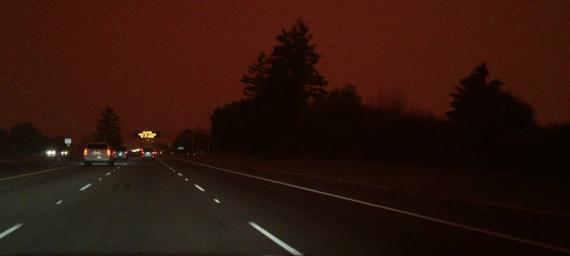This past summer I had the singular pleasure of taking my first ride down to Southern California. In the picture above, one sees the last feeble rays of sunshine as they give way to a long evening to be spent speeding down an Oregon highway.
Except, the picture above was taken at 9:11:36 am. The glow was that of nearby fires and not of celestial rays fanning out from the center of our solar system.
What one witnesses in this picture was the result of the raging wildfires that struck up and down the west coast this past year (many still continue). Growing up in Florida, this was not my first encounter with a natural disaster. I remember vividly how darkness filled our home as we covered every window with wood barriers to dissuade objects from finding their way into our bedrooms and living spaces. It was terrifying then—yet, as I watched not just a home but a whole countryside become engulfed in darkness and choked by ash, I could not help but to think on those feelings of sublime terror recounted by poets and philosophers past.
It also made me think of the work that I and other scholars have undertaken. I am researching and writing now the second chapter of a dissertation whose theme—natural disasters from nineteenth-century German literature—seems to have gained new relevance in the conflagrations and uncertainties of the Anthropocene. I have read with great interest the work of my colleague, Vanessa Hester, whose focus on the invisibility of dangers in the Anthropocene captures the unseen forces that are at work behind such events. And I think on the undertakings of Professor Jason Groves whose work is entangled with innumerous facets of ecological thought. As I stare at the red skies of an Oregon highway lit only by passing headlights and the dim glow of distant fires, I cannot help but feel the weight and importance of the work we are undertaking, and the burden of what is to come.
